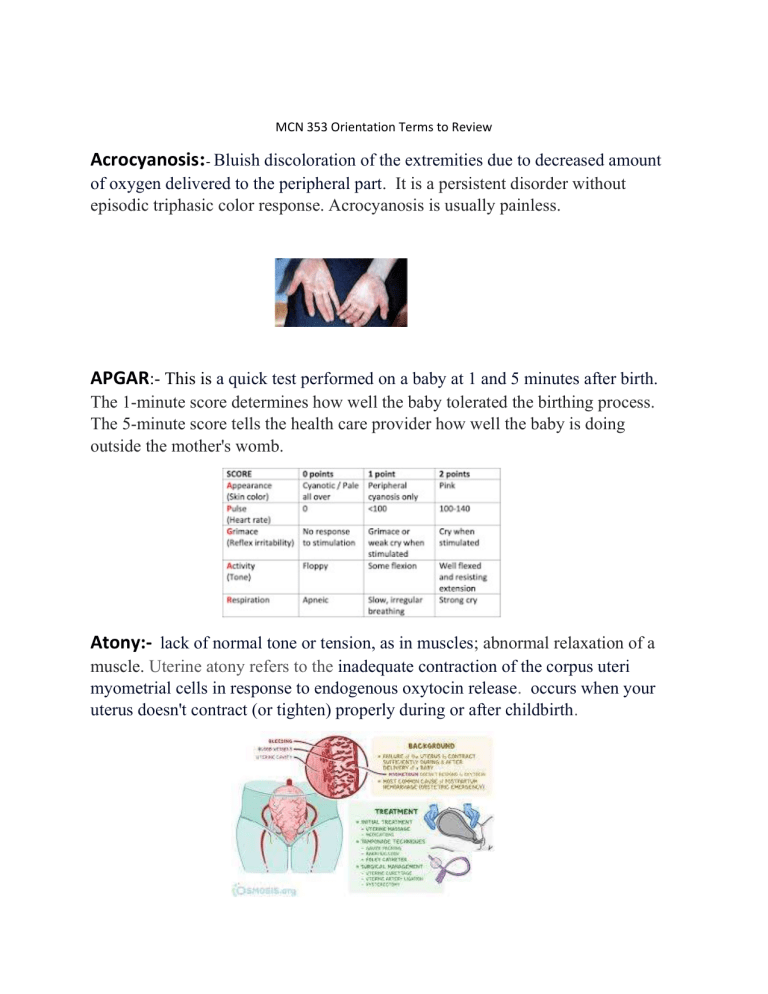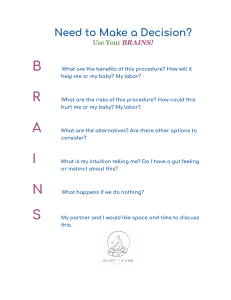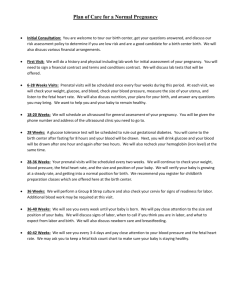
MCN 353 Orientation Terms to Review Acrocyanosis:- Bluish discoloration of the extremities due to decreased amount of oxygen delivered to the peripheral part. It is a persistent disorder without episodic triphasic color response. Acrocyanosis is usually painless. APGAR:- This is a quick test performed on a baby at 1 and 5 minutes after birth. The 1-minute score determines how well the baby tolerated the birthing process. The 5-minute score tells the health care provider how well the baby is doing outside the mother's womb. Atony:- lack of normal tone or tension, as in muscles; abnormal relaxation of a muscle. Uterine atony refers to the inadequate contraction of the corpus uteri myometrial cells in response to endogenous oxytocin release. occurs when your uterus doesn't contract (or tighten) properly during or after childbirth. Bloody show:- is a term that describes bleeding during the end of pregnancy as a woman's body prepares for labor. It's a common symptom of late pregnancy and can be accompanied by other signs of labor like cramping, pelvic pressure, and contractions. Cephalic:- of or relating to the head. : directed toward or situated on or in or near the head Deceleration/ Variable:- decelerations occurring with less than half of contractions, are the most common fetal heart rate abnormality that takes place in labor. Deceleration is a temporary drop in the fetal heart rate. There are three basic types of decelerations: early decelerations, late decelerations, and variable decelerations. Early deceleration is generally normal and not concerning. Late and variable deceleration can sometimes be a sign the baby isn’t doing well. DTR’s:- deep tendon reflex is sometimes called the stretch reflex or myotatic reflex because of the stretch action and the muscle response involved. Effacement:- means that the cervix stretches and gets thinner. This is the thinning and shortening of the cervix. It happens at the end of pregnancy in preparation for childbirth. A pregnant person must be 100% effaced for a vaginal delivery. Dilatation means that the cervix opens. As labor nears, the cervix may start to thin or stretch (efface) and open (dilate). This prepares the cervix for the baby to pass through the birth canal (vagina). EDC:- medical term for the due date is estimated date of confinement (EDC). The average length of human gestation is 280 days, or 40 weeks, from the first day of the woman's last menstrual period. Effleurage:- is a massage therapy technique which encourages waste products to leave the body via the lymphatic system. A system that helps the body get rid of waste. Effleurage is also used to increase blood circulation and prepares the muscle for more vigorous techniques. using circular, rhythmic stroking movements with the palm of your hand to lightly massage your abdomen. Focusing on the rhythm and movement will help your brain “forget” the pain response, which can reduce your pain, and the massage itself can help you relax. Episiotomy:- a cut in the area between the vagina and anus (perineum) during childbirth. An episiotomy makes the opening of the vagina a bit wider, allowing the baby to come through it more easily. Fontanel:- A fontanelle is a 'soft spot' of a newborn baby's skull. It is a unique feature that is important for the normal growth and development of your baby's brain and skull. Fundus:- The part of a hollow organ that is across from, or farthest away from, the organ's opening. For example, the fundus of the uterus is the top part of the uterus that is across from the cervix (the opening of the uterus). FHR:- Fetal heart rate monitoring measures the heart rate and rhythm of your baby (fetus). This lets your healthcare provider see how your baby is doing. GBS:- Group B strep infection (also GBS or group B Streptococcus) is caused by bacteria typically found in a person's vagina or rectal area. A pregnant person with GBS can pass the bacteria to their baby during vaginal delivery. Gravida/Para:- Gravidity (gravida) is the number of times a patient has been pregnant. This includes a current pregnancy. Parity (para) is the number of times a patient has given birth to a viable child Ischial Spine:- This is the position (station) of the baby's head is determined by the relationship of the head to bony projections in the pelvis (ischial spines). The station of the baby's head is measured in the number of centimeters it is above or below these ischial spines. Lanugo:- Lanugo is soft, fine hair covering a fetus while inside the uterus. It helps protect them and keeps them warm while they grow. LMP: The date on which the last menstrual period before the woman conceived began. Lochia/ Rubra:- Lochia rubra refers to vaginal bleeding and discharge that occurs after childbirth. Specifically, it consists of blood, mucus, and tissue from the placenta and the uterus lining. Meconium:- Meconium is the early stool passed by a newborn soon after birth, before the baby starts to feed and digest milk or formula. In some cases, the baby passes meconium while still inside the uterus. This can happen when babies are "under stress" due to a decrease in blood and oxygen supply. Newborn Reflexes:- Babies usually exhibit a full Moro reflex which includes the arms, head, and legs in their first 12 weeks after birth. Also called the startle reflex, Moro reflex usually occurs when a baby gets startled by a loud sound, sudden movement, or intense light. Newborn heart rate/respiratory rate:- The average fetal heart rate is between 110 and 160 beats per minute. It can vary by 5 to 25 beats per minute. The fetal heart rate may change as your baby responds to conditions in your uterus. --- Normally, the newborn's respiratory rate is 30 to 60 breaths per minute. Nuchal Cord:- One or more loops of the umbilical cord may wrap around a baby's neck during pregnancy or labor. A nuchal cord happens when your baby's umbilical cord becomes wrapped around their neck in the womb. Nuchal cords are quite common, and while they often do not cause any health problems, in rare cases, serious complications can occur. ROM:- Rupture of membranes (ROM) or amniorrhexis is a term used during pregnancy to describe a rupture of the amniotic sac. Normally, it occurs spontaneously at full term either during or at the beginning of labor. Station:- Fetal station refers to where the presenting part is in your pelvis. The presenting part. The presenting part is the part of the baby that leads the way through the birth canal. Variability:- variability is defined as fluctuations in the fetal heart rate of more than 2 cycles per minute. Variability is defined as fluctuations in the FHR baseline of 2 cycles per minute or greater, with irregular amplitude and inconstant frequency.



